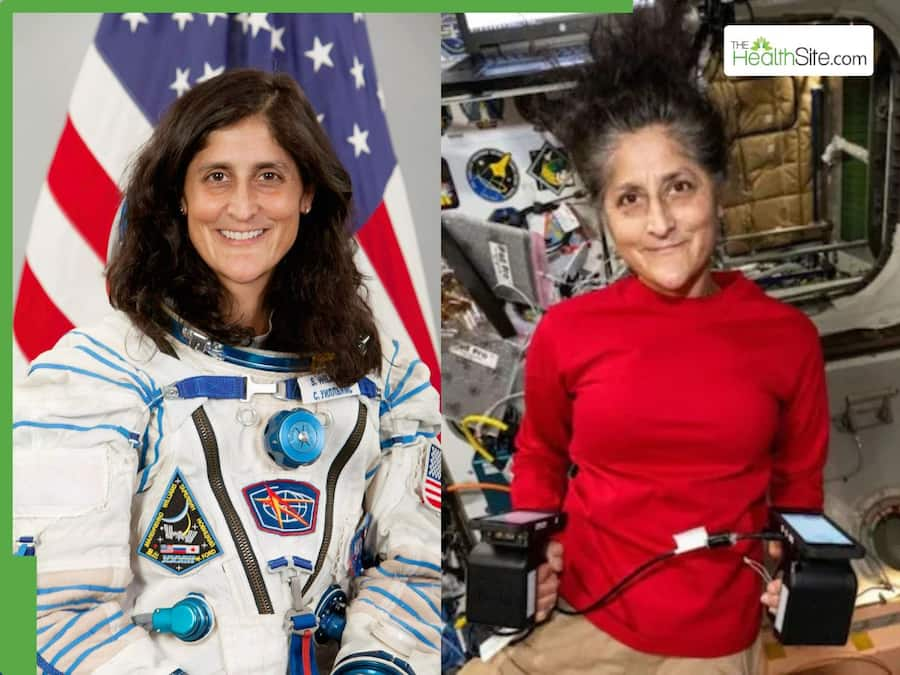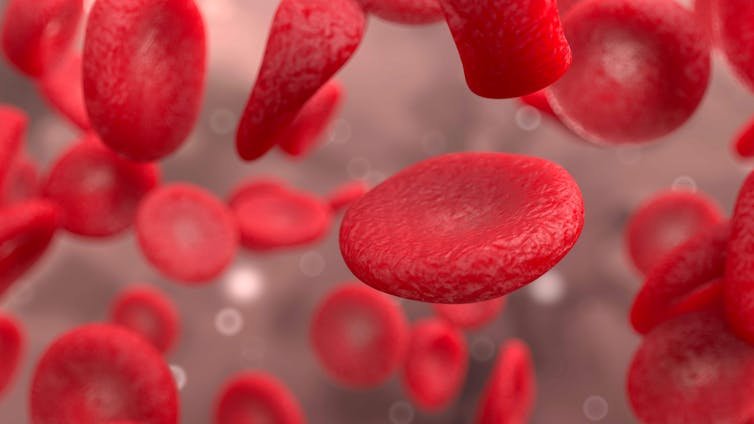NASA Astronaut Sunita Williams has returned to Earth after spending over 9 moths in space – under microgravity. Even though she is back, her body is yet to re-adjust to gravity. But there is another concern rising among experts – did she aged quickly at space?

Sunita Williams Latest Health News: NASA astronaut Sunita Williams recently returned to Earth on March 18, 2025, ending an unexpectedly prolonged stay at the International Space Station (ISS). A short space mission which began on 5th June 2025, was initially planned for an 8-day stay at the ISS. However, it got extended to 286 days due to technical issues with the Boeing Starliner spacecraft, necessitating the astronauts prolonged presence under microgravity.
Even though NASA astronaut Sunita Williams, along with space commander, Barry “Butch” Wilmore has successfully re-entered Earth’s gravity, the recent pictures circulating on social media post-landing have sparked concerns about the toll the prolonged stay at the ISS has taken on the astronaut’s health. Check Sunita Williams’ recent photos HERE:
Home sweet home.
NASA’s SpaceX #Crew9 touched down at Johnson Space Center’s Ellington Field in Houston at 11:19 pm CDT, March 18, after their @Space_Station mission and successful splashdown earlier this afternoon.
Welcome home, Butch, Suni, Nick, & Aleksandr! pic.twitter.com/fbgWiU9ird NASA’s Johnson Space Center (@NASA_Johnson) March 19, 2025
Fragile bones, shrunken chin, facial wrinkles, and white hair of the NASA astronaut in these recent pictures shared on the official handle of the space agency indicate the serious impact of long space stays on the human body. But there is one question that arises from these pictures — did Sunita Williams age faster while she was stuck in space for over 9 months? Can microgravity accelerate the aging process? Let’s understand what NASA has to say.
Did Space Age Sunita Williams? The Impact of 9 Months in Microgravity
Although, space missions have always provided mankind with knowledge about what’s there beyond the sky, the reality is that it comes along with some dangerous side effects that astronauts bear. Prolonged exposure to microgravity can leave the body dealing with severe health issues, including bone density loss, severe muscle weakness, and increased risk of cancer.
However, there is one more topic that has gained momentum in recent days – did Sunita Williams age faster during her 9-month stay at the ISS? According to space studies, this is an exaggerated statement. However, experts say that astronauts do experience significant physiological and biological changes under microgravity due to the lack of atmospheric guard, direct radiation exposure, and isolation.
What Does Microgravity Do To the Human Body? Microgravity, often referred to as “weightlessness,” is a condition where the effects of gravity are significantly reduced. Although gravity is still present in space, objects in orbit around the Earth are in a constant state of free fall, creating an environment where astronauts and objects appear to float. While this might sound like an exciting and fun experience, microgravity has significant effects on the human body.
Sunita Williams Health: What Over 9 Month Stay At Space Did To The NASA Astronaut
While Sunita Williams is back on Earth, experts have suggested that the real challenge for the NASA astronaut will begin now. The bodies will struggle hard to re-adjust to microgravity and learn to live like before. There will be a lot of problems that the astronaut will face while doing simple tasks in day-to-day life, such as walking, body balancing or even standing. But why does this happen? Here is a detailed overview of what a prolonged stay in space does to the human body:
Muscle Atrophy and Bone Density Loss
One of the most well-documented effects of space travel is muscle and bone deterioration. On Earth, gravity provides constant resistance, helping to maintain muscle strength and bone density. In microgravity, the absence of this resistance causes:
- Muscle Atrophy: Astronauts can lose up to 20% of their muscle mass within a few weeks of space travel. This primarily affects weight-bearing muscles like those in the legs and lower back.
- Bone Density Reduction: Astronauts lose about 1% of their bone mass per month in space, significantly increasing the risk of osteoporosis. The hips, spine, and legs are the most affected areas.
- Countermeasures: To combat these effects, astronauts perform resistance exercises, such as weightlifting with specialized equipment, for 2 3 hours daily.
Heart Health Complications
In microgravity, bodily fluids shift upwards, causing “moon face,” where the face appears puffier. The heart also undergoes changes:
- Heart Shrinkage: Without gravity, the heart doesn’t have to work as hard to pump blood, leading to slight atrophy.
- Orthostatic Intolerance: Upon returning to Earth, astronauts may feel dizzy or faint due to their cardiovascular system struggling to readjust.
- Increased Risk of Blood Clots: Studies show that astronauts may have an increased risk of deep vein thrombosis due to altered blood flow.
Space-Induced Vision Problems
Many astronauts report changes in their vision during and after space missions. This is largely due to fluid shifts increasing pressure on the eyeballs, leading to:
- Flattening of the Eyeball
- Swelling of the Optic Nerve
- Changes in Near and Distance Vision
NASA continues to study these effects, as vision impairment poses a serious risk for long-term space travel, including missions to Mars.
Severely Damaged Immune System
Space travel weakens the immune system, making astronauts more susceptible to infections. Studies show that:
- White blood cell counts decrease in microgravity.
- The body’s ability to fight off viruses and bacteria is reduced.
- Stress from isolation, disrupted sleep, and radiation exposure contributes to immune system suppression.
Psychological and Cognitive Effects
Being in space isn’t just physically demanding it’s mentally challenging too. Astronauts experience:
- Cognitive Decline: Some studies suggest a decline in cognitive function due to prolonged exposure to space conditions.
- Sleep Disruptions: The lack of a natural day-night cycle disrupts circadian rhythms, leading to sleep deprivation and fatigue.
- Psychological Stress: Isolation, confinement, and being away from loved ones for extended periods can lead to mood swings, anxiety, and depression.
While these health issues are a matter of concern for the astronauts and their healthy body post-landing. NASA has also revealed why astronauts look aged after coming back from prolonged space missions.
Does Space Travel Accelerate Aging?
Experts believe that the rising speculations about Sunita Williams’ aged 20 years in 9 months is an exaggeration, however, they have pointed out the serious effects of space travel on human bodies and that prolonged stay under microgravity does have aging-like effects on the body. Here are some contributing factors behind it:
- Telomeres, the protective caps on the ends of DNA strands, tend to shorten with age. However, studies on astronaut Scott Kelly (who spent a year in space) showed that his telomeres actually lengthened in space but shortened rapidly upon return to Earth.
- Space radiation exposure leads to increased oxidative stress, a key factor in aging.
- Increased radiation exposure causes DNA damage, which can contribute to premature aging.
- Prolonged exposure to microgravity and radiation may accelerate neurodegenerative processes.
Sunita Williams: What Happens When Astronauts Return to Earth?
The return to Earth is often the most challenging part for astronauts. Some common issues they face include – problems in standing or simply walking, extreme dizziness and disorientation – The vestibular system (which controls balance) needs time to readjust. The most concerning part is suffering from extreme tiredness and fatigue – The body requires weeks or even months to fully recover from prolonged exposure to microgravity.
After returning to Earth last week, our #Crew9@NASA_Astronauts will talk about their mission to the @Space_Station in a news conference at 2:30pm ET (1830 UTC) on Monday, March 31. Get the details and share your questions with #AskNASA: https://t.co/AK9q3EU7XIpic.twitter.com/Vxld26hUwb
NASA (@NASA) March 24, 2025
NASA has stated that on 31st March, at 2:30 pm ET (1830 UTC), the crew 9 will take part in a press conference – the first one since Sunita Williams and Bitch Wilmore returned to Earth. Stay tuned for all the latest updates.




